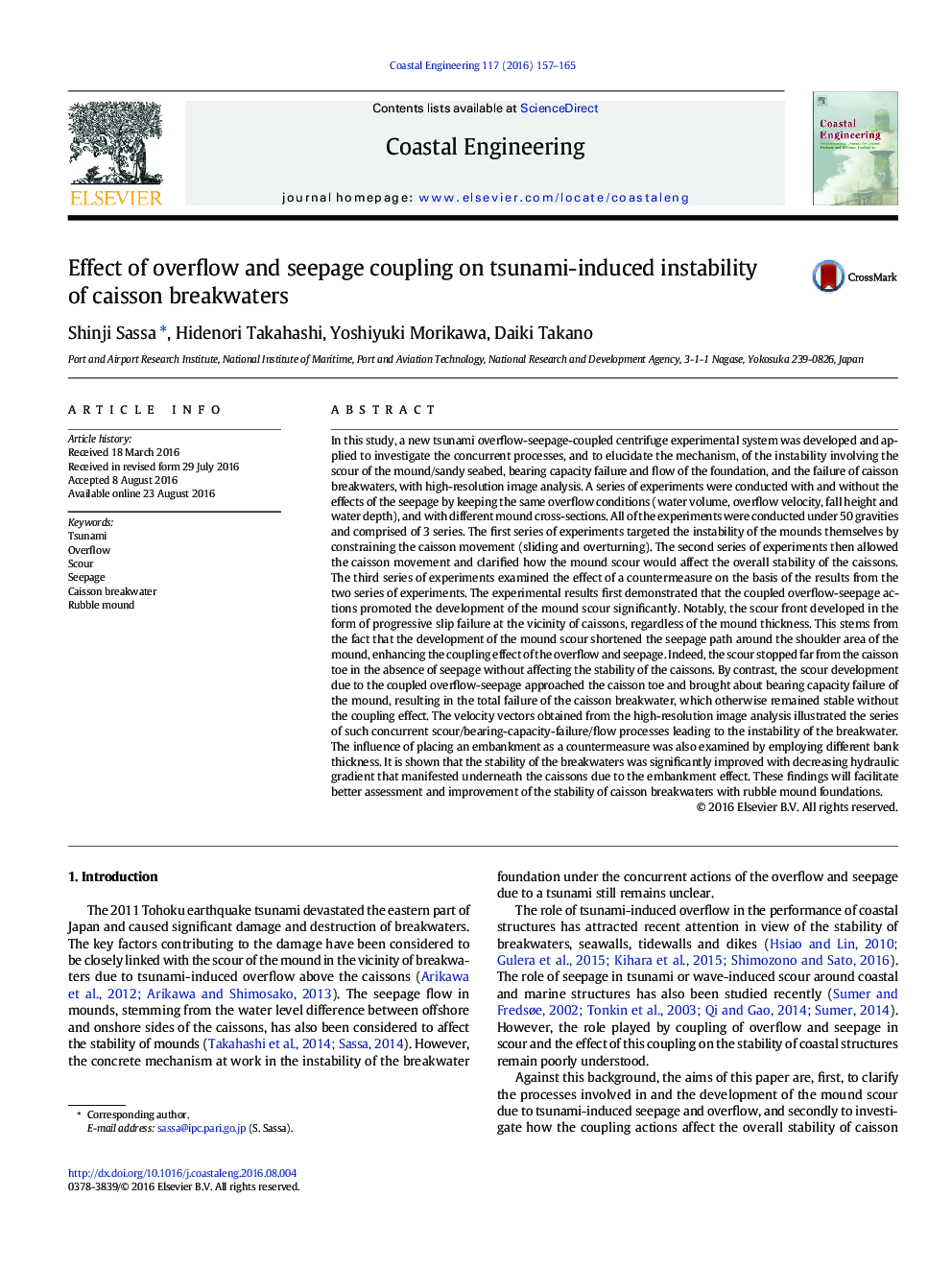| کد مقاله | کد نشریه | سال انتشار | مقاله انگلیسی | نسخه تمام متن |
|---|---|---|---|---|
| 8059627 | 1520337 | 2016 | 9 صفحه PDF | دانلود رایگان |
عنوان انگلیسی مقاله ISI
Effect of overflow and seepage coupling on tsunami-induced instability of caisson breakwaters
ترجمه فارسی عنوان
اثر سرریز و پیوند پیوندی بر ناپایداری ناشی از سونامی موج شکن ها
دانلود مقاله + سفارش ترجمه
دانلود مقاله ISI انگلیسی
رایگان برای ایرانیان
کلمات کلیدی
ترجمه چکیده
در این مطالعه، یک سیستم آزمایشی سانتریفیوژ سانتریفوژ سانتریفوژ سونامی سونامی جدید ایجاد شده و برای بررسی فرآیندهای همزمان و استفاده از مکانیزم، بیثباتی دربرگیرنده حفره دره مایل دره / شنی، شکست ظرفیت باربری و جریان بنیاد و شکست شکست های کاسونس، با تجزیه و تحلیل تصویر با وضوح بالا. مجموعه ای از آزمایش ها با و بدون اثرات نفوذ با حفظ شرایط مشابه سرریز (حجم آب، سرعت سرریز، ارتفاع سقوط و عمق آب) و با مقاطع مختلف کوره انجام شد. تمام آزمایشات زیر 50 گرات انجام شد و شامل 3 سری بودند. سری اول آزمایشات، بی ثباتی خود را با محدود کردن جنبش کاسونوس (لغزاندن و سرنگونی) را هدف قرار داد. سپس آزمایش دوم، جنبش کاسسون را مجاز می دانست و توضیح می دهد که چطور می تواند باعث تثبیت کلی کایسون ها شود. سری سوم آزمایشات اثر ضد اندازه گیری بر اساس نتایج دو سری آزمایش انجام شده است. نتایج تجربی برای اولین بار نشان داد که اقدامات ناشی از انباشت سرریز شده به طور قابل ملاحظه ای موجب توسعه معادن شن و ماسه شد. به طور قابل توجهی، جبهه پاشش، به رغم ضخامت تپه، به شکل شکاف پیشرونده لغزش در مجاورت کایسون گسترش یافت. این ناشی از این واقعیت است که توسعه تپه تپه مسیر مسیر نفوذ در اطراف ناحیه شانه تپه را کوتاه می کند، و موجب افزایش اثر اتصال سرریز و نفوذ می شود. در حقیقت، شستشو در غیاب نفوذ بدون تأثیر بر ثبات کایسون، دور از انگشت شست پا متوقف شد. در مقابل، توسعه آبشاری به علت پراکنده شدن بیش از حد مخزن، منجر به نزول کاسنس شد و موجب افتادن ظرفیت تحمل گودال شد، و منجر به شکست کامل موج شکنها شد که در غیر این صورت با اثر جفت ثابت باقی می ماند. بردارهای سرعت حاصل از تجزیه و تحلیل تصویر با وضوح بالا نشان داد که مجموعه ای از چنین فرآیندهای شکستگی / تحمل / شکست جریان / همزمان جریان منجر به بی ثباتی موج شکن. تأثیر قرار دادن خاکریز به عنوان یک اقدام ضد اندازه گیری نیز با استفاده از ضخامت باندهای مختلف مورد بررسی قرار گرفت. نشان داده شده است که ثبات موج شکن ها به طور قابل توجهی با کاهش شیب هیدرولیکی که در اثر کانیس ها بوجود می آید به علت اثر خاکریزی بهبود می یابد. این یافته ها، ارزیابی بهتر و بهبود پایداری موج شکن ها را با پایه های سنگ گودال تسهیل می کند.
موضوعات مرتبط
مهندسی و علوم پایه
سایر رشته های مهندسی
مهندسی دریا (اقیانوس)
چکیده انگلیسی
In this study, a new tsunami overflow-seepage-coupled centrifuge experimental system was developed and applied to investigate the concurrent processes, and to elucidate the mechanism, of the instability involving the scour of the mound/sandy seabed, bearing capacity failure and flow of the foundation, and the failure of caisson breakwaters, with high-resolution image analysis. A series of experiments were conducted with and without the effects of the seepage by keeping the same overflow conditions (water volume, overflow velocity, fall height and water depth), and with different mound cross-sections. All of the experiments were conducted under 50 gravities and comprised of 3 series. The first series of experiments targeted the instability of the mounds themselves by constraining the caisson movement (sliding and overturning). The second series of experiments then allowed the caisson movement and clarified how the mound scour would affect the overall stability of the caissons. The third series of experiments examined the effect of a countermeasure on the basis of the results from the two series of experiments. The experimental results first demonstrated that the coupled overflow-seepage actions promoted the development of the mound scour significantly. Notably, the scour front developed in the form of progressive slip failure at the vicinity of caissons, regardless of the mound thickness. This stems from the fact that the development of the mound scour shortened the seepage path around the shoulder area of the mound, enhancing the coupling effect of the overflow and seepage. Indeed, the scour stopped far from the caisson toe in the absence of seepage without affecting the stability of the caissons. By contrast, the scour development due to the coupled overflow-seepage approached the caisson toe and brought about bearing capacity failure of the mound, resulting in the total failure of the caisson breakwater, which otherwise remained stable without the coupling effect. The velocity vectors obtained from the high-resolution image analysis illustrated the series of such concurrent scour/bearing-capacity-failure/flow processes leading to the instability of the breakwater. The influence of placing an embankment as a countermeasure was also examined by employing different bank thickness. It is shown that the stability of the breakwaters was significantly improved with decreasing hydraulic gradient that manifested underneath the caissons due to the embankment effect. These findings will facilitate better assessment and improvement of the stability of caisson breakwaters with rubble mound foundations.
ناشر
Database: Elsevier - ScienceDirect (ساینس دایرکت)
Journal: Coastal Engineering - Volume 117, November 2016, Pages 157-165
Journal: Coastal Engineering - Volume 117, November 2016, Pages 157-165
نویسندگان
Shinji Sassa, Hidenori Takahashi, Yoshiyuki Morikawa, Daiki Takano,
